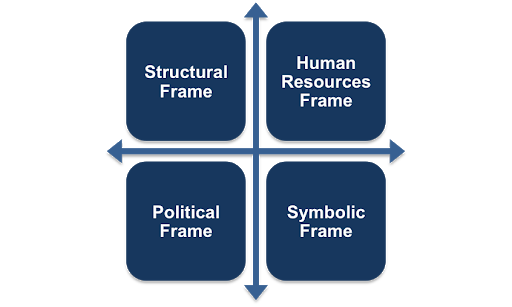When I started my MBA journey at UBC Sauder School of Business, one of the first things that really sparked my interest into defining and developing my own leadership style were the Four Frames of Leadership. This Four-Frame model was originally outlined by Lee Bolman and Terri Deal in their book, Reframing Organizations: Artistry, Choice and Leadership (1991). Bolman and Deal stated that for leaders to be effective in devising a strategy or solution around organizational issues, their approach should come from four different perspectives, which they call habitual “frames” of reference. These four frames are:

Structural Frame
This behavioral frame is mainly a task-oriented frame which focuses on the obvious “how” of change. It concentrates on strategy; setting measurable goals; clarifying tasks, responsibilities and reporting lines; agreeing metrics and deadlines; and creating systems and procedures.
Assumptions
- goals get results
- develop well-structured solutions
- specialization, rules & policies
- chains of command
- analysis, data & accountability
Questions
- What is our goal?
- What steps need taking?
- Who needs to do what by when?
- How can we measure the results?
Behaviors
goal setting; budgeting; evaluation; management & control systems
Human Resources Frame
This behavioral frame focuses more emphasis on people’s needs. It chiefly focuses on giving employees the power and opportunity to perform their jobs well, while at the same time, addressing their needs for human contact, personal growth, and job satisfaction.
Assumptions
- people are most valued resource
- take control, meet human needs; relationships and feelings
- facilitation, empowerment; consensus
- help employees fit the organization (e.g. selection, training)
Questions
- How will this issue impact our staff?
- How do we get employees’ input and buy-in?
- What skills are necessary? How do we get them?
- How can we motivate staff?
Behaviors
participative anagement; recruitment; training; quality of work life; communication skills, coaching
Political Frame
The Political Frame addresses the problem of individuals and interest groups having sometimes conflicting (often hidden) agendas, especially at times when budgets are limited and the organisation has to make difficult choices. In this Frame you will see coalition-building, conflict resolution work, and power-base building to support the leader’s initiatives.
Assumptions
- conflict and competition are fact of life
- goal: secure critical resources
- negotiation; power; networking
Questions
- Where can we get more resources?
- Potential obstacles?
- Who is competing for these resources?
- Where is our power base? Who do we need as allies?
Behaviors
negotiation; managing conflict; networking; creating coalitions; building a power base; managing the agenda
Symbolic Frame
This behavioral frame focuses on inspiring people by making an organisation’s direction feel significant and distinctive. It includes creating a motivating vision, and recognising superb performance through company celebrations. The Symbolic Frame addresses people’s needs for a sense of purpose and meaning in their work.
Assumptions
- reality is socially constructed; “multiple realities”
- create shared meaning
- organizational culture; vision; mission
- tools: symbols, rituals, ceremonies, stories
Questions
- What are our values? How can they focus our attention?
- What do our symbols and artificacts say about us?
- How can we capture our attention and other consituents’ perception?
- How can we communicate our values?
Behaviors
visioning; slogans; images; rituals; “walking the talk”